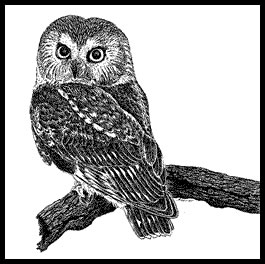| |
| |
| |
| |
| |
| |
| |
| |
| |
| |
| NORTHERN
SAW-WHET OWL |
 |
| The Munchkin-like
saw-whet seems to have been designed by WaltDisney. This appealing,
diminutive owl, seven inches long and weighing all of 3 1/2 ounces,
appears to be all head and great golden eyes. The eyes are set off by
a white V-shaped patch that becomes larger and less sharply delineated
after the bird's first year. It is difficult to think of this sprite
as a predator, but the saw-whet is armed with needle-sharp talons, and
mice and songbirds as well as insects fall prey to it. This is the smallest
owl found in the East (believe it or not, a few western species are
even tinier), and it can be distinguished from the screech owl, another
little species, by its smaller size, rounded head and lack of ear tufts.
Its odd name comes from one of its characteristic calls, which (to some
ears, at least) sounds like a saw being sharpened on an old-fashioned
whetting stone. The call does have a raspy, metallic quality, and the
notes produced occur in groups of three. Another saw-whet call with
a metallic quality is a ping or zing that sounds very
much as if it were made by a grasshopper. It is actually produced by
the male saw-whet during the spring courtship period. By imitating these
calls at night, you might be lucky enough to lure the elfin owl within
viewing range. Otherwise, this is a hard species to see in the wild.
The saw-whet prefers dense forest, and usually uses a thicket or clump
of trees as a roosting site. Stands of pine or hemlock and rhododendron
or honeysuckle bushes are all favored, and the little owl prefers a
low perch; it is seldom seen in high branches. This tiny bird, like
other owl species, enhances the camouflaging effect of its cryptic coloration
by remaining virtually motionless during the day. If you do spot a saw-whet,
however, you'll discover that this is a remarkably tame species that
will put up with an amazing amount of human disruption and camera-brandishing
before it decides to seek quieter quarters. The saw-whet is migratory,
and in some winters the Northeast records unusually large numbers of
northern migrants. The number seems to depend upon the amount of food
available to these little owls in the northern forest. This is a nocturnal hunter, one that is seldom seen moving about in daylight unless it is driven from its perch by a particularly determined mob of other birds. This behavior, called mobbing, is manifested by many birds, from bold chickadees, nuthatches and mockingbirds to blue jays and crows, against all birds of prey. The object is not to physically harm the predator, but to warn other birds of potential danger by constantly calling and flying close to the raptor. Mobbing may also get the harassed raptor to move on. To other birds of prey, particularly to other owls, the tiny saw-whet is an easy meal, so this predator frequently becomes the preyed-upon. It is often a victim of severe winter storms that prevent it from hunting. Another all-too-common fate is a collision with a car as the owl swoops down over a highway to snatch up a mouse. |
| |